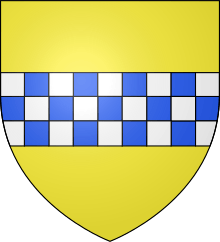Walter Stewart, 6th High Steward of Scotland
| Walter Stewart | |
|---|---|
| 6th High Steward of Scotland | |
 Coat of arms of High Steward of Scotland | |
| Born | c. 1296 |
| Died |
9 April 1327 Bathgate Castle |
| Noble family | House of Stewart |
| Spouse(s) |
Marjorie Bruce Isabel de Graham |
| Father | James Stewart, 5th High Steward of Scotland |
| Mother | Giles de Burgh |
| Religion | Roman Catholic |
Walter Stewart (c. 1296[1][2] – 9 April 1327 at Bathgate Castle[1]) was the 6th hereditary High Steward of Scotland. He was also the father of King Robert II of Scotland.
Biography
He was the son of James Stewart, 5th High Steward of Scotland and Giles (or Egidia) de Burgh, daughter of Walter de Burgh, 1st Earl of Ulster.[3] Walter's mother is sometimes identified as Cecily or Cecilia de Dunbar (his father's first wife), but this identification is erroneous.
Walter fought on the Scottish side at the Battle of Bannockburn in 1314[4] commanding, with Douglas, the left wing of the Scots' Army.[2] According to another version of events, he was the nominal leader of one of the four Scottish schiltrons, but because of his youth and inexperience, its effective leader was his cousin James Douglas, Lord of Douglas.[5] This is, however, disputed, as some claim that there were only three Scottish schiltrons at Bannockburn.[6] For his services at Bannockburn, Walter was appointed Warden of the Western Marches and rewarded with a grant of the lands of Largs, which had been forfeited by John Balliol. In 1316, Stewart gifted these lands to Paisley Abbey.[7]
Upon the liberation of Robert the Bruce's wife, Elizabeth de Burgh, and daughter Marjorie from their long captivity in England, the High Steward was sent to receive them at the Anglo-Scottish Border and conduct them back to the Scottish court.[2] He later married Marjorie, receiving the Barony of Bathgate in Linlithgowshire as part of his wife's dowry.[8]
During the Bruce's absence in Ireland the High Steward and Sir James Douglas managed government affairs and spent much time defending the Scottish Borders. Upon the capture of Berwick-upon-Tweed from the English in 1318 he got command of the town which, on 24 July 1319 was laid siege to by King Edward II of England. Several of the siege engines were destroyed by the Scots' garrison and the Steward suddenly rushed in force from the town to drive off the enemy. In 1322, with Douglas and Thomas Randolph, he made an attempt to surprise the English King at Byland Abbey, near Malton, Yorkshire. Edward, however, escaped, pursued towards York by the Steward and 500 horsemen.[2]
Walter, Steward of Scotland, made a charter to John St. Clair, his valet, of the lands of Maxton, Roxburghshire, circa 1320/1326, one of the witnesses being "Roberto de Lauwedir (Robert de Lauder) tunc justiciario Laudonie" (Justiciar of Lothian).[9]
Family and issue
Walter married, in 1315, Marjorie, only daughter of Robert I of Scotland by his first wife Isabella of Mar. Walter and Marjorie had one son:[10]
Walter later married Isabel de Graham, frequently identified as a daughter of Sir John Graham of Abercorn. They had three children:[11]
- John Stewart of Ralston or Cunninghame.
- Andrew Stewart, knight.
- Egidia Stewart, who married, first, Sir James Lindsay of Crawford; second, Sir Hugh Eglinton; and third, Sir James Douglas of Dalkeith.
Death and burial
Walter, 6th High Steward of Scotland, died on 9 April 1326 at Bathgate Castle. He was buried at the Abbey Church of Paisley, alongside his first wife, Marjorie Bruce, and the previous five high stewards. An engraved memorial on the floor of the abbey reads in part:
In everlasting memory of the high stewards of Scotland. Here rest their bodies where stood the high altar of this Abbey Church of Paisley.[12]
| Preceded by James Stewart |
High Steward of Scotland 1309–1327 |
Succeeded by Robert II of Scotland |
Ancestry
| Ancestors of Walter Stewart, 6th High Steward of Scotland | ||||||||||||||||||||||||||||||||||||||||||||||||||||||||||||||||||||||||||||||||||||||||||||||||||||||||||||||||||||||||||||||||||||||||||||||||||||||||||||||||||||||||||||||||||||||||||||||||||||||||||||||||||||||||||||||||||||||||||||||||||||||||||||||||||||||||||||||||||||||||||||||||||||||||||||||||||||||||||||||||||||||||||||||||||||||||||||||||||||||||||||||||||||||||||||||||||||||||||||||||||||||||||||||||||||||||||||||||||||||||||||||||||||||||||||||||||||||||||||||||||||||||||||||||||||||||||||||||||||||||||||||||||||||||||||||||||||||||||||||||||||||||||||||||||||||||||||||||
|---|---|---|---|---|---|---|---|---|---|---|---|---|---|---|---|---|---|---|---|---|---|---|---|---|---|---|---|---|---|---|---|---|---|---|---|---|---|---|---|---|---|---|---|---|---|---|---|---|---|---|---|---|---|---|---|---|---|---|---|---|---|---|---|---|---|---|---|---|---|---|---|---|---|---|---|---|---|---|---|---|---|---|---|---|---|---|---|---|---|---|---|---|---|---|---|---|---|---|---|---|---|---|---|---|---|---|---|---|---|---|---|---|---|---|---|---|---|---|---|---|---|---|---|---|---|---|---|---|---|---|---|---|---|---|---|---|---|---|---|---|---|---|---|---|---|---|---|---|---|---|---|---|---|---|---|---|---|---|---|---|---|---|---|---|---|---|---|---|---|---|---|---|---|---|---|---|---|---|---|---|---|---|---|---|---|---|---|---|---|---|---|---|---|---|---|---|---|---|---|---|---|---|---|---|---|---|---|---|---|---|---|---|---|---|---|---|---|---|---|---|---|---|---|---|---|---|---|---|---|---|---|---|---|---|---|---|---|---|---|---|---|---|---|---|---|---|---|---|---|---|---|---|---|---|---|---|---|---|---|---|---|---|---|---|---|---|---|---|---|---|---|---|---|---|---|---|---|---|---|---|---|---|---|---|---|---|---|---|---|---|---|---|---|---|---|---|---|---|---|---|---|---|---|---|---|---|---|---|---|---|---|---|---|---|---|---|---|---|---|---|---|---|---|---|---|---|---|---|---|---|---|---|---|---|---|---|---|---|---|---|---|---|---|---|---|---|---|---|---|---|---|---|---|---|---|---|---|---|---|---|---|---|---|---|---|---|---|---|---|---|---|---|---|---|---|---|---|---|---|---|---|---|---|---|---|---|---|---|---|---|---|---|---|---|---|---|---|---|---|---|---|---|---|---|---|---|---|---|---|---|---|---|---|---|---|---|---|---|---|---|---|---|---|---|---|---|---|---|---|---|---|---|---|---|---|---|---|---|---|---|---|---|---|---|---|---|---|---|---|---|---|---|---|---|---|---|---|---|---|---|---|---|---|---|---|---|---|---|---|---|---|---|---|---|---|---|---|---|---|---|---|---|---|---|---|---|---|---|---|---|---|---|---|---|---|---|---|---|---|---|---|---|---|---|---|---|---|---|---|---|---|---|---|---|---|---|---|---|---|---|---|---|---|---|---|---|---|---|---|---|---|---|---|---|---|---|---|---|---|---|---|---|---|---|---|---|---|---|---|---|---|---|---|---|---|---|---|---|---|---|---|---|---|---|---|---|---|---|---|---|---|---|---|---|---|---|---|---|---|---|---|---|---|---|---|---|---|---|---|---|---|---|
| ||||||||||||||||||||||||||||||||||||||||||||||||||||||||||||||||||||||||||||||||||||||||||||||||||||||||||||||||||||||||||||||||||||||||||||||||||||||||||||||||||||||||||||||||||||||||||||||||||||||||||||||||||||||||||||||||||||||||||||||||||||||||||||||||||||||||||||||||||||||||||||||||||||||||||||||||||||||||||||||||||||||||||||||||||||||||||||||||||||||||||||||||||||||||||||||||||||||||||||||||||||||||||||||||||||||||||||||||||||||||||||||||||||||||||||||||||||||||||||||||||||||||||||||||||||||||||||||||||||||||||||||||||||||||||||||||||||||||||||||||||||||||||||||||||||||||||||||||
References
- 1 2 G. W. S. Barrow, ‘Stewart family (per. c.1110–c.1350)’, Oxford Dictionary of National Biography, Oxford University Press, 2004.
- 1 2 3 4 Anderson, William, The Scottish Nation, Edinburgh, 1867, vol.ix, p.513, states he was 21 years of age at Bannockburn.
- ↑ Cal.Doc Scot. vol ii, no 847
- ↑ Simpson, David, The Genealogical and Chronological History of the Stuarts, Edinburgh, 1713.
- ↑ John Prebble The Lion in the North
- ↑ Peter Traquair Freedom's Sword
- ↑ Stewart, James King (1901). The Story of the Stewarts. Edinburgh: George Stewart & Co. p. 75-76. Retrieved 12 January 2017.
- ↑ Stewart. Story. p. 75-76.
- ↑ Angus, William, editor, Miscellaneous Charters 1315-1401, in Miscellany of The Scottish History Society, vol.5, 1933, p.9.
- ↑ Weir, Alison (2008). Britain's Royal Families: The Complete Genealogy. London: Vintage. p. 215. ISBN 978-0099539735.
- ↑ Weir. Britain's Royal Families. p. 215.
- ↑ "Sir Walter Stewart". Find a Grave. Retrieved 12 January 2017.
Further reading
- Burke, Messrs., John and John Bernard, The Royal Families of England Scotland and Wales, with Their Descendants &c., London, 1848, volume 1, pedigree LXVIII, and volume 2 (1851) page xlvi.
- Clay, John W., FSA., editor, The Visitation of Cambridge, 1575 and 1619 by Henery St.George, Richmond Herald, Harleian Society, London, 1897, pps: 7 - 11.
- Dunbar, Sir Archibald H., Bt., Scottish Kings, a Revised Chronology of Scottish History, 1005 - 1625, Edinburgh, 1899, pps: 126 - 144.
- Louda, Jiri, & Maclagan, Michael, Lines of Succession, London, 1981.
- Weis, Frederick Lewis, et all, The Magna Charta Sureties 1215, 5th edition, Baltimore, 2002, p. 50.